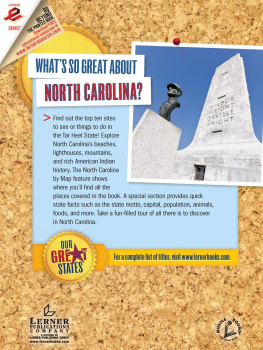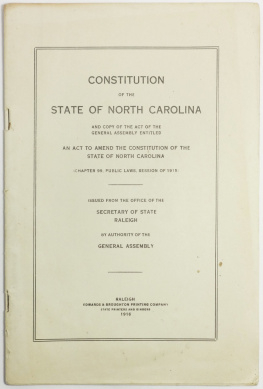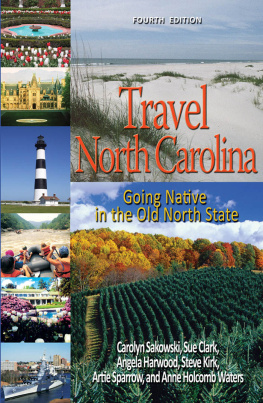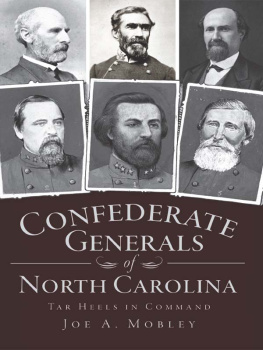1991 The University of North Carolina Press
All rights reserved
Manufactured in the United States of America
The paper in this book meets the guidelines for permanence
and durability of the Committee on Production Guidelines for
Book Longevity of the Council on Library Resources.
95 94 93 92 91 5 4 3 2 1
Library of Congress Cataloging-in-Publication Data
Trelease, Allen W.
The North Carolina Railroad, 18491871, and the modernization of North Carolina / by Allen W. Trelease.
p. cm. (The Fred W. Morrison series in Southern studies)
Includes bibliographical references and index.
ISBN 0-8078-1941-7 (cloth : alk. paper)
1. North Carolina Railroad CompanyHistory.
2. RailroadsNorth CarolinaHistory19th century.
I. Title. II. Series.
HE2791.N82398 1991
385.065756dc20
90-39189
CIP
PREFACE
IN SOME RESPECTS the North Carolina Railroad was typical of Americas early railways: small in size, built and operated on a shoestring, run by inexperienced and often part-time managers, and destined soon to be swallowed by larger roads. Even in the NCRRs own day, physical structures and rolling stock were seldom described and less photographed; most of the pictures we have date from later times.
In other respects the NCRR was not so typical. Largely a state-owned enterprise, it was subject to continuing political influence; the governor appointed a majority of its board of directors as well as a state proxy empowered to cast 30,000 of the 40,000 votes at stockholders meetings. The NCRR was also the states largest business corporation, its longest railroad (223 miles), its largest source of revenue, and its chief reliance for economic growth and modernization. Leased (but not sold) to other roads after 1871, it became a vital link in the Southern Railway system forged by J. P. Morgan in the 1890s. Unlike most parts of that network (now the Norfolk Southern), the NCRR remains in the ownership of the corporation that built it in the 1850s, three-quarters of whose stock still belongs to the state of North Carolina.
North Carolina was often characterized in the 1840s as the Rip Van Winkle Stateasleep for the past generation, increasingly backward and poverty-stricken, and closed to new ideas, especially if they cost money. The NCRR did much to remove that image, contributing over the years to the economic growth of its own territory and that of the world beyond. The Piedmont Urban Crescent, following the road from Raleigh through Greensboro to Charlotte, is clearly attributable to it, although existing towns helped attract the railroad in the first place. The NCRRs broader impact is not easily measured, given the roads rapid integration into an ever-larger regional, national, and international transportation network. In the following chapters, especially the final one, I will attempt to describe and assess that impact during the latter half of the nineteenth century.
The greatest attention, however, will go to the NCRRs development as an independently operating railroad from the time of its charter in 1849 until its lease to the Richmond and Danville Railroad in 1871. These twenty-two years fall naturally into three partsbefore, during, and after the Civil Wareach relatively distinct. The prewar years were the time of inception, construction, and early operation, including the first through traffic agreements with connecting roads north, south, and east. During the war the NCRR played a vital role in supporting (not always adequately) the Confederate military effort in Virginia, and many of the wars last scenes were played out along its tracks in April 1865. After the war the road experienced several kinds of reconstruction. Physical rehabilitation of its property and the recovery of the regional economy on which the road depended took place amid political changes that inescapably affected its management. Finally, the postwar railway consolidation movement, creating a national rail network, soon engulfed the NCRR, putting its operations into the hands of outsiders and strangers.
The NCRR charter of 1849 was a product of sectional compromise. Western North Carolinians wanted a railroad to connect projected South Carolina and Virginia roads running northward to Charlotte and southward to Danville, Virginia. This north-south axis promised to confirm the existing flow of western North Carolina products to neighboring states. Easterners agreed to charter a road from Charlotte, therefore, only if it headed eastward and connected at Goldsboro with an existing railroad that terminated in Wilmington. Their purpose was to direct western trade as much as possible toward North Carolina ports.
That aim was frustrated from the beginning by several factors. In the first place, Wilmington and the other North Carolina ports were inferior to those of Norfolk and Charleston. Secondly, shipping and insurance rates around Cape Hatteras were higher than those to Norfolk in particular. Finally, the two existing railroads of eastern North Carolina, both of which were to connect with the NCRR, led toward Virginia. If the southern terminus of the Wilmington and Weldon Railroad was Wilmington, its northern terminus was on the Roanoke River, with easy rail access to both Norfolk and Richmond. The second road, the Raleigh and Gaston, would soon also run to Weldon and the same rail connections into Virginia. The NCRR thus became from the outset primarily a north-south railway linking South Carolina and points farther south with Norfolk, Richmond, and points farther north. Later wartime construction of the controversial link from Danville to the NCRR at Greensboro reinforced that role.
The NCRR was built to more than the minimal standards prevailing in the 1850s. But abrupt grades and inadequate ballasting and drainage facilities would create perennial maintenance and operational problems and even take a few lives. The repair shops, built at the roads midpoint in Alamance County, served as the nucleus of a new railroad-owned town, Company Shops, which a generation later would take the name of Burlington.
The road was built, as it was operated, primarily by black labor. Neighboring slaveholders took construction contracts and used their slaves to clear and grade the roadbed. The road itself hired slaves by the year to hew crossties, lay track, and build water tanks, stations, and bridges. Hired slaves subsequently filled the section gangs that maintained the roadway, and they comprised most of the station hands and train crews as well. After the war, with a brief exception, free blacks performed the same roles. Whites held the prestigious jobs as engineers, conductors, foremen, machinists, and other skilled shopworkers, but they also served along with blacks as firemen, brakemen, and relatively unskilled shopworkers.
Train service began in 1854 at opposite ends of the line while construction proceeded in the middle. With the completion of the road in January 1856, agreements were quickly made for through service, both freight and passenger, with connecting roads; almost immediately the NCRR became an important link in a chain of railroads and steamship lines providing service between New York and New Orleans. As on most railroads, there was always tension between through service and local service for travelers and shippers who lived along the NCRR. It extended to both schedules and fares. Local users preferred daytime trains and cheap local rates. But since they had almost no alternative to the NCRR, they lacked bargaining power. The NCRR and its connecting roads were competing for through traffic with rival lines along the coast and on the other side of the mountains. Hence they usually fixed train schedules and charged rates to suit longdistance users. The result was higher rates and middle-of-the-night trains for the roads closest and most dependent customers.








